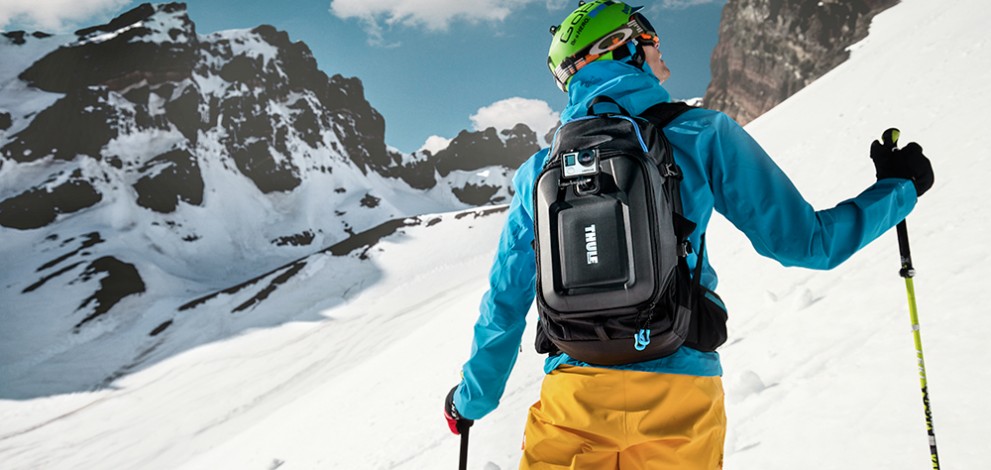Outdoor photography is taking new forms with action cams, drones and other electronics, proving there’s still a market for versatile camera bags.
By M.T. Elliott
The days of lugging heavy and large DSLR cameras and lenses are dwindling among amateur photographers (among the pros, we see more gear than ever), and camera bag manufacturers are evolving with the trend.
The next wave of electronic equipment carry solutions follows the arrival of action cameras, drones and tablets. The new camera options have helped us see old icons like El Capitan and Utah’s red canyon walls from fresh angles.
We talked to brands to see what’s trending in the space.
New Arrows Need New Quivers
Picture a close-up shot of a mountain bike’s fork suspension compressing as it crunches over a large rock, cut to a sweeping pan of bikers snaking along a riverside trail. One was shot with an action camera, the latter with a drone. Both offer unique perspectives and have become must-have options in the outdoor photographer’s bag of tricks.
The small size of action cameras and versatile mount options give brands confidence to design with those in mind. In fact, the durability of most action cameras means they can safely attach to the outside of a photo bag and take footage instead of hiding away. It’s often photographers needing today’s camera bags for a many different mounts and batteries that require specific storage options.
Thule designed its Legend GoPro Backpack with the photographer as part of the action. Multiple camera mounts allow for filming from different angles, sternum and hip straps secure the pack on a ride or hike, and behind the crushproof pad is a hydration system compartment.
“We typically partner with brands that are leading in their respective industries, like Apple and GoPro,” said Chris Ritchie, Thule’s communications manager. “That being said, we are always looking to create products that help people carry the things that keep them active and outdoors.”
Just as action cameras enable new shots from tight spaces, drones give photographers a way to capture views of more remote locations, which is why there’s a demand for a bag that can withstand those environments.
Unlike the early dominance of the GoPro model among action cameras, drones are still settling on sizes, and accessories like propellers and batteries are still in flux. Drones are obviously bulkier than action cameras, and while sturdy enough to survive crashes, can be brittle when pressed at other angles.
Enter Lowepro’s DroneGuard BP 450 AW, a sturdy outdoor backpack built for any destination, which accommodates the most popular quadcopter shapes. Designed with expected changes in mind, the DroneGuard forgoes a form-fitting insert and uses guards that fit the DJI Phantom in one configuration, and rotates to fit the 3DR Solo.
Luis Quehl, senior design manager at DayMen, Lowepro’s parent, noted that because of a drones’ fragility, the drone bags incorporate plastic molded walls for more rigidity and protection than traditional photography backpacks.
“I see people traveling with these drones. And I’m not just looking into the future, this is something I see currently happening, people wanting to get those vacation photos with a drone,” said Quehl. “They want to have those great memories and get them from a different perspective.”
Because drones are used outdoors, drone buyers are — or quickly becoming — attuned to the need for protection from the elements. That could send the drone bag buyer to the nearest outfitter for a shell or other gear. Several bag designers said they already use drones and noted the established connection between the outdoor space and photography. Beyond photography, drones are being used to show off real estate, check on livestock and slowly becoming a toy for racing with other hobbyists. It’s likely they’ll want their investments protected from drops and bad weather, too.
The Crossover Shake-up
Last year, Peak Design’s Everyday Messenger bag raised millions on Kickstarter from more than17,000 backers and won acclaim from gear reviewers. The bag’s success online and in retail is based on access and expansion; compartments that expand when you need them to, and collapse when you don’t. Hikers and city slickers prefer not to haul around an empty foam form.
Peak Designs won loyalty from its camera clips and its bag created waves.
“We’ve carved out a niche for ourselves as an innovation company,” said Art Viger, an industrial designer with Peak Design. “We design all of our hardware and webbings for the application.”
Where retailers should take note is Peak’s crowd funding audience, which stays in touch with the bag makers. A recent poll for new colors drew 800 responses overnight. “I think that every product we’ve done that’s been out for more than a year has had at least a dozen tweaks on it, generally way more than that, because we’re constantly harvesting feedback, and we keep our production runs frequent and rather small,” Viger said.
The coming second run of the Everyday Messenger Bag will incorporate roughly 25 changes — most of which you’d never notice. Despite the online success, Peak Designs still aims for retail space in outdoor and travel outfitters, not just camera shops. Viger said Peak has found a correlation in those audiences. “With adventure comes camera gear.”
Look for brands to expand upon the typical camera bag with adaptability and modern styles. Outdoor retailers may want to consider these crossover bags, especially for urban outdoor audiences, since the aesthetics don’t broadcast the expensive goodies inside.
Beyond day bags there is certainly room for more serious outdoor photography bags for activities like backcountry skiing. Attachment systems to hold anything from a water bottle to a shell pouch are options outdoor enthusiasts immediately recognize. Mountainsmith is going full Cordura, extending the name-brand toughness through its entire line of bags.
Adventure photographers will hit the camera store for the hardware, but trust an outdoor store to orders bags with their type of travel in mind.
Photo courtesy Thule










